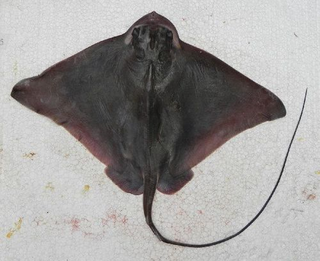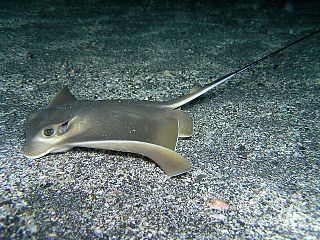
The eagle rays are a group of cartilaginous fishes in the family Myliobatidae, consisting mostly of large species living in the open ocean rather than on the sea bottom.

The pygmy beaked whale, also known as the bandolero beaked whale, Peruvian beaked whale and lesser beaked whale, is the smallest of the mesoplodonts and one of the newest discoveries. There were at least two dozen sightings of an unknown beaked whale named Mesoplodon sp. A before the initial classification, and those are now believed to be synonymous with the species. The species was formally described in 1991, based on ten specimens obtained from Peru between 1976 and 1989, including a 3.72 m (12.2 ft) adult male as the type specimen. A specimen that stranded at Paracas, Peru in 1955 has since been identified as a pygmy beaked whale. Since 1987, there have been an additional 40 sightings of the species, for a total of 65.

The Andean cock-of-the-rock, also known as tunki (Quechua), is a large passerine bird of the cotinga family native to Andean cloud forests in South America. It is the national bird of Peru. It has four subspecies and its closest relative is the Guianan cock-of-the-rock.

Myliobatis is a genus of eagle rays in the family Myliobatidae.

The New Zealand eagle ray or Australian eagle ray is an eagle ray of the family Myliobatidae, found in bays, estuaries, and near rocky reefs around New Zealand and southern Australia on the inner continental shelf. It is a common species and the International Union for Conservation of Nature has assessed its conservation status as being of "least concern".
Telmatobius peruvianus, also known as the Peru water frog, is a species of frog in the family Telmatobiidae. This semiaquatic frog is endemic to Andean highlands in southeastern Peru and far northern Chile where found in streams and small rivers. It is threatened by habitat loss, pollution, collection for human consumption and infection by chytrid fungi, and it has not been seen in Chile since 1986.

The Andean swift is a species of bird in subfamily Apodinae of the swift family Apodidae. It is found in Argentina, Bolivia, Chile, and Peru.

The Chilean eagle ray is a species of fish in the family Myliobatidae. Found off the coasts of Chile and Peru, its natural habitat is open sea.

The purple eagle ray is a species of fish in the family Myliobatidae. It was formerly considered endemic to Australia but is now known to be more widespread. Its natural habitat is the open seas where it has a patchy distribution, and the International Union for Conservation of Nature has assessed its conservation status as being "near-threatened".
The longnose eagle ray or snouted eagle ray is a species of fish in the family Myliobatidae. It is found in the East Pacific Ocean from Baja California and the Gulf of California to Sechura, Peru, ranging from shallow water to a depth of 64 m (210 ft). This species was first described in 1964 by the American ichthyologist Shelton Pleasants Applegate, who was an expert on fossil and living sharks, and by American marine biologist John Edgar Fitch.

Microlophus peruvianus, the Peru Pacific iguana, is a species of lava lizard endemic to the Ecuador, Peru, and Chile. The species is commonly attributed to the genus Microlophus but has been attributed to the genus Tropidurus.

Lobatus peruvianus, commonly known as the Peruvian conch or the cock's comb conch, is a species of large sea snail, a marine gastropod mollusk in the family Strombidae, the true conchs and their allies.

The common eagle ray or bullray is a species of fish in the family Myliobatidae. It inhabits the eastern Atlantic Ocean, the Mediterranean Sea and the south-western Indian Ocean.
The shortnose eagle ray is a species of eagle ray that lives in the southwestern Atlantic Ocean off Brazil, Uruguay and Argentina.

The bullnose ray is an eagle ray, which is widely distributed in the western Atlantic. It is found at depth above 10 m (33 ft) in coastal waters from Cape Cod down to Argentina, but is absent from parts of the western central Atlantic. It reaches a maximum size of 106 cm (42 in) in disc width and gives birth to six young per litter. It is often confused with the southern eagle ray. The bullnose ray feeds mostly hermit crabs, gastropods, and bivalves.

The Peruvian pipit is a species of bird in the family Motacillidae native to Chile and Peru.

The Southern eagle ray, sometimes known as the Southern eagle fish or the rockfish, is a ray species in the family Myliobatidae. It lives in waters just off of the Atlantic coast, from the tip of Florida down to Argentina, inhabiting estuaries or bays to give birth during spring and summer and migrating to the open sea in autumn and winter. It has an average width of 99 centimeters, and a length of 60 centimeters. It is often confused with the bullnose ray, a related species in the genus Myliobatis, due to the two species' similarities in appearance.

The Japanese eagle ray, also known as the cowhead eagle ray or kite ray is a ray species in the family Myliobatidae.
Exocoetus peruvianus, commonly known as the Peruvian flyingfish, is a species of ray-finned fish endemic to the tropical southeast Pacific Ocean in the waters off Peru and Ecuador.
















